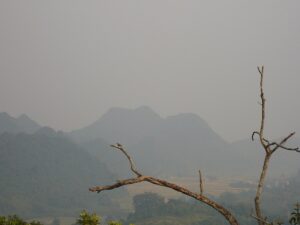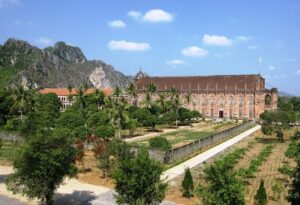Nho Quan district in the northwest of Ninh Binh province is relatively unknown to international tourism. Situated around 34km from Ninh Binh City and 127km from Hanoi, the district encompasses 450km² of land with a population density of only 331.4/km², mainly centered around the capital city of the same name.
This vast mountainous region boasts more lakes than any other district in Vietnam, an abundance of caves, a significant population of the Người Mường (Muong) ethnic group and extensive natural forests. It is also home to Cuc Phuong National Park – the oldest and largest protected forest reserve in Vietnam.
Recent excavations at the Nguoi Xua Cave (Động Người Xưa) in Cuc Phuong National Park, have uncovered human artifacts dating back 10,000 years. The findings provided evidence of prehistoric settlements now considered to be the ancient ancestors of the current Vietnamese population.
Conservation
Cuc Phuong National Park plays a vital role in conservation of the abundant flora, fauna, and bird life in North Vietnam. Despite its comparatively small land area, Vietnam is home to approximately 10% of the world’s total plant and animal species, ranking 16th globally for biological diversity.
The park’s success is critical to the ecology of the nation and the region. Since the early 1990’s, researchers have discovered at least 490 species of mammals, birds, fish, plants, and amphibians previously unknown to science. However, despite extensive conservation efforts poachers and wildlife smugglers still pose a significant threat to the park’s biodiversity.
As a result of its ancient karst topology, Nho Quan’s extensive cave systems include well-known Thiên Hà and Động Vân Trình caves. The area is also home to the Động Nham Hao cave system, one of the longest water caves in the country but rarely visited due to its remote location.
The many lakes of the district are considered a crucial resource for aquaculture, irrigation and tourism. Among these lakes, Hồ Đồng Chương (Dong Chuong Lake) is the most renowned and has been identified it as a potential location for ecotourism. Nearby attractions like the Ba Tua waterfall, Chin Suoi river, and the blue water pond at Troi also attract visitors to the area.
Historical Significance
Nho Quan’s history is as old as Vietnam itself. Recognized as the birthplace of Duong Van Nga, the wife of Dinh Bo Lin and often considered the “Mother Goddess” of Vietnam, the district is also home to numerous significant spiritual and historical sites. The Temple of Heaven in Tho hill, the King Dinh Bo Linh temple in Lao Cau village, and the communal houses of My Ha, Ngoc Nhi, and Ngoc Ba in Gia Thuy are worthy of note. Unfortunately these sites are spread far and wide across the region which can make casual tourism difficult.
The Chau Son Cistercian Monastery Church in Phu Son commune merits special recognition. Constructed in 1939, the church has strong ties to the Cathedral at Phat Diem in the southern district of Kim Son. A large gothic church built with local red brick featuring a large 21m high white dome, it is only a few kilometers away from Nho Quan town. An easy destination if you are already in the area.
Boasting magnificent scenery, abundant biodiversity, a rich history, exciting caves and ancient temples, Nho Quan is a fantastic future eco-tourism destination. Currently the main impediment to fame is its relatively long distance from the main tourist hubs at Trang An-Tam Coc and a general lack of knowledge of its many wonders. For those with an adventurous spirit and a desire to witness the real Vietnam up close, Nho Quan offers a great opportunity for an unusual and rewarding trip to Ninh Binh’s heartland.



